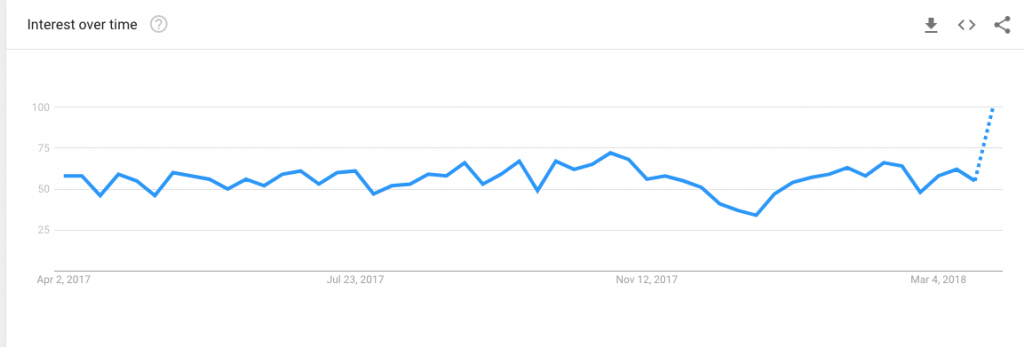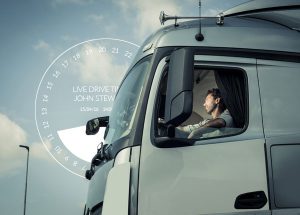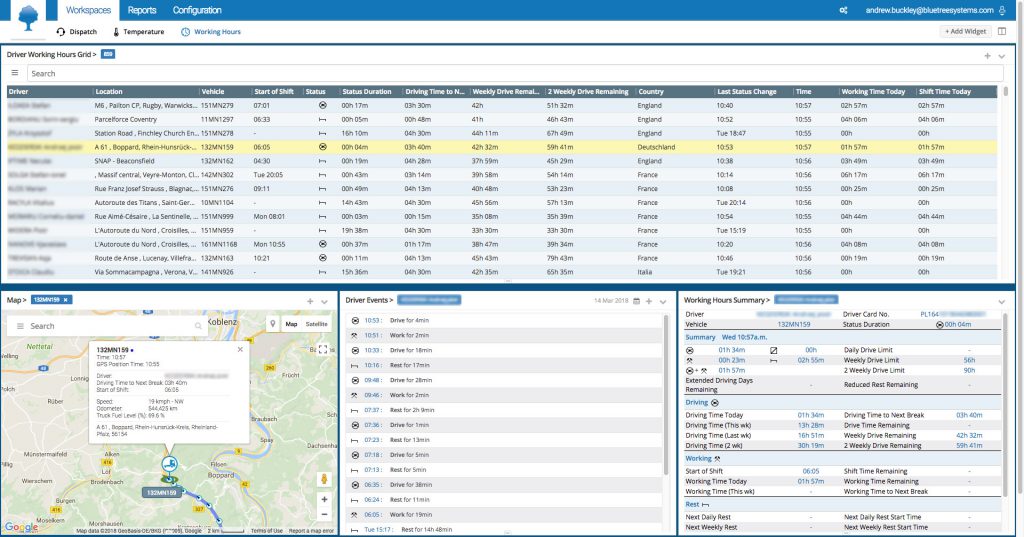
Tachograph Rules: What European Drivers and Hauliers Need to Know
- Blog
- Transportation
- Tachograph Rules: What European Drivers and Hauliers Need to Know
- Apr 12, 2018
- Denis Cody
 “How long can drivers legally work in a day?”
“How long can drivers legally work in a day?”
“What vehicles require a tachograph?”
“What are tachograph regulations? What are tacho breaks?”
These are just some of the Google search terms used around tacho and tachographs. It shows that while HAU drivers and hauliers may well be familiar with the broad tachograph legislation, there are plenty of nuances and country differentiations to consider.

Image via Google Trends, worldwide search for “Tachograph” over 12 months.
Although European and International tachograph regulations have been in place for decades, new entrants to the trucking market and even veterans still have questions. Here we take a closer look at the regulations across the EU and how international and domestic rules work hand-in-hand.
European Tachograph Rules Combining Domestic and International Rules
 The EU regulations underpin truck safety campaigns and rules at a national level.
The EU regulations underpin truck safety campaigns and rules at a national level.
Heavy Goods Vehicles (HGVs) have a defined set of base rules that govern working hours. These rules govern the working hours and outline daily and fortnightly driving times as well as rest breaks. The objectives of the rules include improving road safety by reducing driver fatigue, avoiding competitive driving and improve working conditions for drivers within the EU.
The common rules of Regulation (EC) no. 561/2006 cover driving times for road haulage and passenger vehicles. It encompasses international and national journeys, over long and short distances, employees and self-employed and drivers for their own account and for hire and reward.
The rules are measured using a tachograph. Tachographs collect driving time, speed and distance and are used to make sure drivers and employers follow the drivers’ hours rules.
The rules that apply to drivers in the EU include:
- European Commission Driving Time and Rest Periods
- European Agreement concerning the Work of Crews of Vehicles engaged in International Road Transport (AETR)
- Domestic Rules
These rules are part of an international and national effort in creating awareness and ensuring a continued road safety emphasis across the region. In addition to European rules, many EU countries have their own national rules and campaigns.
Adhering to two sets of tachograph rules can be complex, as drivers and carriers need to negotiate both. For example:
- (EC) 165/2014 is a requirement for digital tachographs in vehicles over three-point-five tones total weight, including the trailer.
- (EC) 561/2006 defines rules for drivers of vehicles which fall under 165/2014 regarding Shift-, Work-, Drive- and Rest-time.
- 2003/88/EC non-enforceable EU Working Time Directive.
- All members of the EU must incorporate the directive into their national legislation. This can lead to several different interpretations being enforced across the EU. 2002/15/EC takes precedence over relevant provisions of the basic Directive 2003/88/EC on working time because it contains more specific provisions.
The main EU rules on drivers’ hours state maximum driving hours of:
- Nine hours in a day; this can be exceeded – up to 10 hours – twice in a week.
- 56 hours of driving in one week.
- 90 hours over any consecutive two-week period.
The tachograph rules also govern rest breaks and obligations of drivers who must take:
- At least 45 minutes of a break for every four and a half hours of driving. This can be a single 45-minute break, or a single 15-minute break and a 30-minute break.
- An unbroken rest period of 45 hours each week.
- At least one 45-hour rest and on 24-hour rest in any two-week period.
- A weekly rest after six consecutive 24-hour work periods.
How Do Tacho Rules Differ Across Europe?
Here’s a look at how the legislation differs in some European regions:
Tachograph Regulations in Germany, Austria, Switzerland
The Federal Office for Goods Transport (BAG) carries out inspections onsite and at the roadside. These are in cooperation with transport authorities and the police to ensure compliance with national and international legislation and regulations.
The rules specific to Germany include:
- FPersG / FPersV transforms the above EU legislation and regulation into binding German law. National legislation might be stricter than the EU basis.
- 2003/88/EC non-enforceable EU Working Time Directive. All members of the EU have to incorporate the directive into their national legislation. This leads to several different interpretations being enforced across the EU.
- ArbZG (21a) German law which incorporates 2003/88/EC. 21a is specifically addressing workers which fall under (EC) 561/2006.
France Drivers’ Hours Rules
In France, as with other EU countries, there are two key areas of legislation: EU Directives and National French Laws. French rules are unique and complex for several reasons including:
- Drivers’ wages must be based on the hours read from the tachograph.
- There are additional rules, such as the principle of service time.
- “Availability time” is strictly counted as work which impacts on potential working hours and drive time capacity.
French law contains further regulations around labour rules, night hours, overtime and travel expenses:
- g. Work time, Decree 83-40 “Short distance driver “, “Parcel services driver”.
- g. French “Aubry II” Law of February 1st, 2000.
Driver’s Hours Rules in Great Britain
In Great Britain, it remains to be seen what part Brexit will play on national legislation. However, one thing is likely: a continuing focus on keeping roads as safe as possible. The Driver and Vehicle Standards Agency (DVSA) sets the rules on Great Britain’s (GB) drivers’ hours and tachographs for goods vehicles in GB. Within Great Britain, either UK domestic or EU rules apply.
Drivers are obliged to use a tachograph if the vehicle comes under EU or AETR rules.
Great Britain’s driving limit includes the following:
- No more than 10 hours in a day on a public road. No more than 10 hours a day off-road if it’s outside of duty time.
- Drivers cannot be on duty for more than 11 hours in any working day.
- Drivers must follow GM domestic rules of 10 hours in a day. If driving in the EU, a driver must follow all EU driving limits.

ORBCOMM’s FleetManager enhances compliance with tachograph rules and working time legislation, and improves driver performance, fleet safety, efficiency, and productivity.
Tachograph Rules Beyond the EU
For journeys outside the EU, where the countries are signatories to the AETR, drivers are subject to AETR rules. For journeys that are partly in the EU and partly in countries that are neither in the EU nor AETR signatories, EU rules apply to the journey portion in the EU. Countries outside either the EU or AETR are likely to have their own regulations around driving hours that should be adhered to.
The Future of Tachograph Beyond 2018
In January 2018, the European Commission’s Joint Research Centre released the European’s 60 Stories for the 60th Anniversary, a document that gives a timeline and a story that is deemed of relevance to EU citizens. JRC Senior Scientist Jean-Pierre Nordvik said: “Safer transport involves hidden technologies as well as fancy driver aids.”
While not everyone will agree with the description of a tachograph in that way, it’s clear that the digital tachograph is a fundamental element in enforcing European social legislation for professional truck drivers” and is now deployed in more than 50 countries.
There are a lot of elements to understand for drivers, hauliers and anyone associated with tachographs. The elements increase as borders come into play and pan-European transportation increases.
As reliance on technology increases, tachographs continue to change and innovate. Smart tachographs are the next phase of evolution and will be mandatory by June 15, 2019. The new generation will feature advanced digital technologies, like satellite position and short-range communications, automatic reading of journey times and deliver remote access.
Hauliers can rely on ORBCOMM’s Tachograph solution to ensure up-to-date compliance with national and international legislation. To learn more, contact us at sales@orbcomm.com.

As ORBCOMM’s Senior Director of Product Marketing, Denis Cody leverages over two decades of industry experience in international B2B marketing to help develop and execute GTM strategies, positioning and messaging for our suite of products and solutions.
















